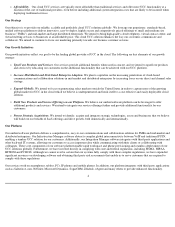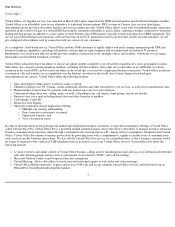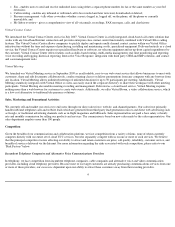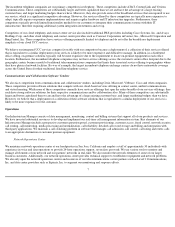8x8 2014 Annual Report Download - page 18
Download and view the complete annual report
Please find page 18 of the 2014 8x8 annual report below. You can navigate through the pages in the report by either clicking on the pages listed below, or by using the keyword search tool below to find specific information within the annual report.
The market for cloud communications and collaboration services is subject to rapid technological change, and we depend on new
product and service introductions in order to maintain and grow our business.
We operate in an emerging market that is characterized by rapid changes in customer requirements, frequent introductions of new and enhanced
products, and continuing and rapid technological advancement. To compete successfully in this emerging market, we must continue to design,
develop, manufacture, and sell new and enhanced cloud communications and collaboration products and services that provide higher levels of
performance and reliability at lower cost. If we are unable to develop new services that address our customers' needs, to deliver our applications
in one seamless integrated product offering that addresses our customers' needs, or to enhance and improve our services in a timely manner, we
may not be able to achieve or maintain adequate market acceptance of our services. Our ability to grow is also subject to the risk of future
disruptive technologies. Access and use of our services is provided via the cloud, which, itself, has been disruptive to the previous premise-
based
model. If new technologies emerge that are able to deliver communications and collaboration services at lower prices, more efficiently, more
conveniently or more securely, such technologies could adversely impact our ability to compete.
Maintaining adequate research and development personnel and resources is essential to new product development and continued innovation, and
we intend to increase our investment in research and development activities to add new features and services to our offerings. If we are unable to
develop new features and services internally due to certain constraints, such as high employee turnover, lack of management ability or a lack of
other research and development resources, we may miss market opportunities. Further, many of our competitors expend a considerably greater
amount of funds on their research and development programs, and those that do not may be acquired by larger companies that would allocate
greater resources to our competitors' research and development programs. In addition, there is no guarantee that our research and development
efforts will succeed, or that our new products and services will enable us to maintain or grow our revenue or recover our development costs. Our
failure to maintain adequate research and development resources, to compete effectively with the research and development programs of our
competitors and to successfully monetize our research and development efforts could materially and adversely affect our business and results of
operations.
We may not be able to scale our business quickly enough to meet our customers' growing needs and if we are not able to grow
efficiently, our operating results could be harmed.
As usage of our communications and collaboration services by mid-market and larger distributed enterprises expands and as customers continue
to integrate our services across their enterprises, we will need to devote additional resources to improving our application architecture,
integrating our products and applications across our technology platform, integrating with third-party systems, and maintaining infrastructure
performance. As our customers gain more experience with our services, the number of users and transactions managed by our services, the
amount of data transferred, processed and stored by us, the number of locations where our service is being accessed, and the volume of
communications managed by our services have in some cases, and may in the future, expand rapidly. In addition, we will need to appropriately
scale our internal business systems and our services organization, including customer support and services, to serve our growing customer base.
Any failure of or delay in these efforts could cause impaired system performance and reduced customer satisfaction. These issues could reduce
the attractiveness of our cloud communications and collaboration services to customers, resulting in decreased sales to new customers, lower
renewal rates by existing customers, the issuance of service credits, or requested refunds, which could hurt our revenue growth and our
reputation. Even if we are able to upgrade our systems and expand our staff, any such expansion will be expensive and complex, requiring
management time and attention and increasing our operating expenses. We could also face inefficiencies or operational failures as a result of our
efforts to scale our infrastructure. Moreover, there are inherent risks associated with upgrading, improving and expanding our information
technology systems. We cannot be sure that the expansion and improvements to our infrastructure and systems will be fully or effectively
implemented on a timely basis, if at all. These efforts may reduce revenue and our margins and adversely impact our financial results.
To provide our services, we rely on third parties for all of our network connectivity and co-location facilities.
We currently use the infrastructure of third-party network service providers, including the services of Equinix, Inc., and Level 3
Communications, Inc., to provide all of our cloud services over their networks rather than deploying our own networks.
We also rely on third-party network service providers to originate and terminate substantially all of the PTSN calls using our cloud-based
services. We leverage the infrastructure of third party network service providers to provide telephone numbers, PSTN call termination and
origination services, and local number portability for our customers rather than deploying our own network throughout the United States. This
decision has resulted in lower capital and operating costs for our business in the short-term, but has reduced our operating flexibility and ability
to make timely service changes. If any of these network service providers cease operations or otherwise terminate the services that we depend
on, the delay in switching our technology to
14
























